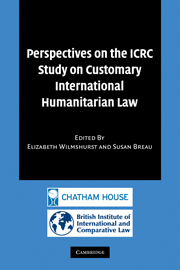Book contents
- Frontmatter
- Contents
- Preface
- List of contributors
- Table of cases
- Table of treaties and other instruments
- Abbreviations
- Part 1 Setting the scene: Theoretical perspectives on international law in the ICRC Study
- Part 2 The status of conflict and combatants: The ICRC Study
- 4 Status of armed conflicts
- 5 Combatant status
- Part 3 Commentary on selected Rules from the ICRC Study
- Part 4 Conclusions
- Index
5 - Combatant status
Published online by Cambridge University Press: 09 July 2009
- Frontmatter
- Contents
- Preface
- List of contributors
- Table of cases
- Table of treaties and other instruments
- Abbreviations
- Part 1 Setting the scene: Theoretical perspectives on international law in the ICRC Study
- Part 2 The status of conflict and combatants: The ICRC Study
- 4 Status of armed conflicts
- 5 Combatant status
- Part 3 Commentary on selected Rules from the ICRC Study
- Part 4 Conclusions
- Index
Summary
Introduction
The question of combatant status and what this means has been subjected to public scrutiny in recent years because of the plight of persons held by the United States under executive authority. While the internment of civilians and prisoners of war in time of armed conflict is not a new phenomenon, the conditions of their internment being laid down in the Geneva Conventions of 1949, some of those at Guantanamo Bay seemed to fall into an intermediate category, being classed neither as prisoners of war nor civilians and labelled as ‘enemy combatants’.
Normally, combatants are entitled to be treated as prisoners of war so, at first sight, this seems a little curious. But, in practice, things are not always as straightforward as they might seem. There is no doubt that an international armed conflict was taking place in Afghanistan in 2001. It was not uncommon for citizens of neutral, or even coalition, States to go to Afghanistan to fight with local militias against the coalition forces. Suppose X is one of these persons and he has joined a militia group and has been issued with an assault rifle. All dressed in the local civilian dress the group take part in an ambush of a coalition military patrol, by firing a rocket-propelled grenade, and destroy a military vehicle. Its occupants are unhurt, having dismounted in time. After a brief exchange of fire, X, who has not fired a single round, is captured.
- Type
- Chapter
- Information
- Publisher: Cambridge University PressPrint publication year: 2007



